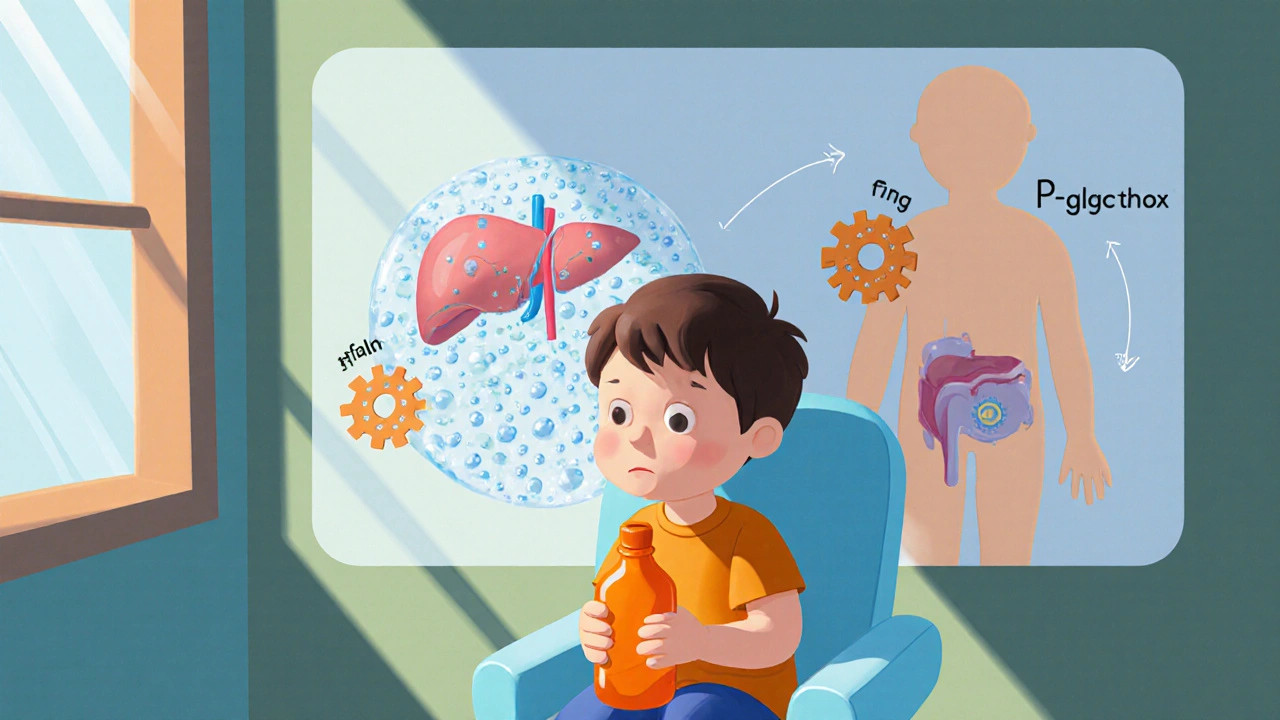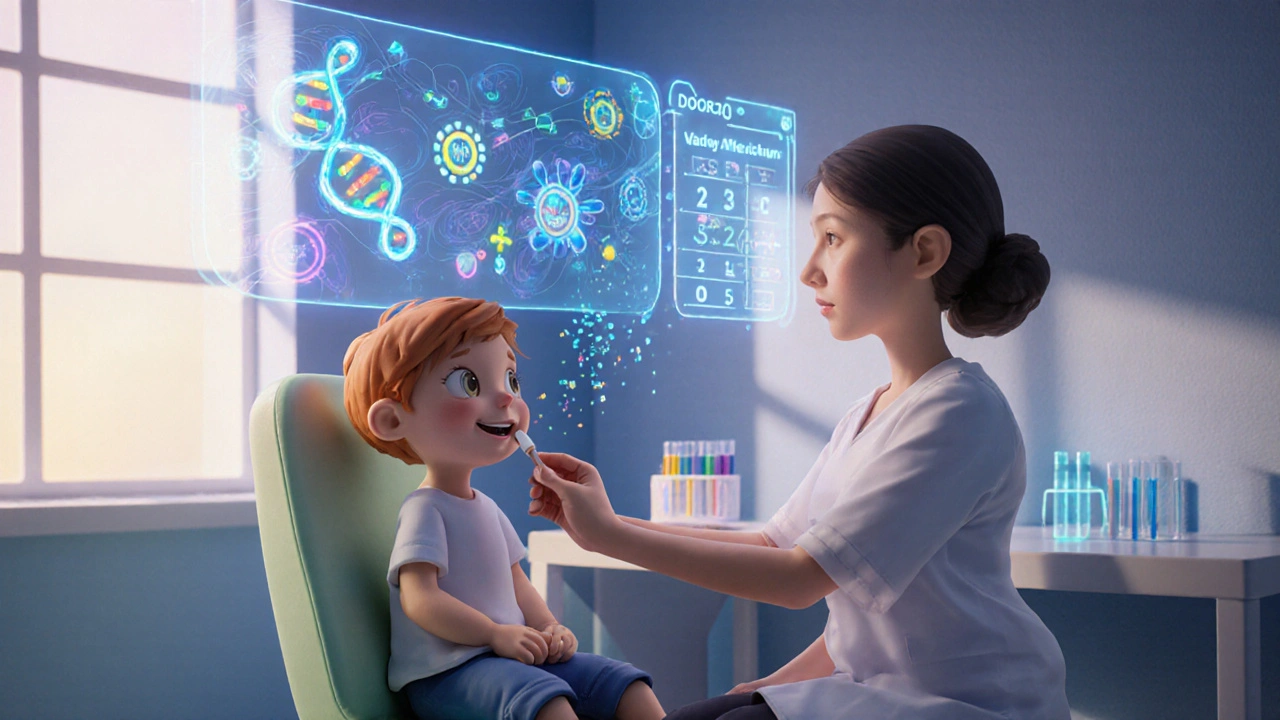Pediatric Drug Side Effects: Why Kids React Differently

Oct, 25 2025
Pediatric Dosing Calculator
Calculate Safe Medication Dose for Children
Determine appropriate pediatric medication doses based on child's weight, age, and specific drug. Includes risk assessment for common pediatric medications.
Ever wondered why a simple cough syrup can make a child dizzy while the same dose barely raises an adult’s eyebrows? The answer lies in the unique way children process medicines, and the fallout can be serious. Below, we break down the biology, the biggest risk factors, and what parents and clinicians can do to stay ahead of the curve.
What are Pediatric medication side effects adverse reactions that occur when children respond differently to drugs compared to adults?
These side effects aren’t just occasional hiccups-they account for nearly 10 % of childhood hospitalizations, with half of those cases life‑threatening, according to a 2023 Columbia University study led by Dr. Nicholas Giangreco. The problem is rooted in developmental pharmacology: children’s bodies are constantly changing, from water composition to liver enzyme activity.
Why children react differently - the science behind the numbers
Three biological factors drive the disparity:
- Body composition. Infants are 75‑80 % water, versus about 60 % in adults, diluting water‑soluble drugs and altering distribution.
- Immature organ function. Neonates possess only 30‑40 % of adult cytochrome P450 activity. By the first year, some enzymes surge to 100‑200 % of adult levels, creating a moving target for dosing.
- Dynamic drug transporters. Transport proteins such as P‑glycoprotein mature at different ages, influencing how quickly a drug is expelled from cells.
Because of these shifts, dosing is weight‑based (mg/kg) and often age‑tiered: premature infants, neonates, infants, toddlers, preschoolers, school‑age children, and adolescents each have distinct guidelines defined by the World Health Organization.
Key risk factors that tip the scales toward serious reactions
A 2024 systematic review (PMCID: PMC11350535) identified three recurring culprits:
- Low age - newborns and toddlers show the highest susceptibility.
- Chronic comorbidities - asthma, epilepsy, and congenital heart disease magnify drug interactions.
- Polypharmacy - taking three or more medications simultaneously raises ADE odds by roughly 20 %.
These factors often overlap, especially in NICU settings where 79 % of drugs are used off‑label.
High‑risk drugs every parent should recognize
The KIDs List a catalog of medications with higher risk profiles for children flags several culprits. Below is a quick comparison of the most concerning agents.
| Drug | Common Use | Typical Pediatric Side Effect | Serious Risk |
|---|---|---|---|
| Loperamide | Anti‑diarrheal | Constipation, abdominal cramps | Fatal cardiac arrhythmia in < 6 yr |
| Aspirin | Pain/fever reducer | Reye’s syndrome (≈1/1,000 viral infections) | Severe liver & brain damage |
| Codeine | Cough suppressant | Respiratory depression in ultra‑rapid metabolizers | Death (1/30 children) |
| Montelukast | Asthma maintenance | Psychiatric effects (3.2‑fold higher risk at age 2) | Suicidal ideation |
| Metoclopramide | Antiemetic | Extrapyramidal movement disorders | 4.1‑fold increased risk in adolescents |
These numbers aren’t abstract; they translate into real‑world emergencies. For example, the FDA’s MedWatch program logged 12,347 pediatric adverse reports in 2022, with antibiotics (48 %) and CNS drugs (18 %) topping the list.
Spotting the warning signs - common vs. severe
Most kids experience mild effects: headache, nausea, or mild rash, affecting roughly 15‑20 % of medication courses. These usually fade after a few days. However, watch for red flags that demand immediate medical attention:
- Difficulty breathing or wheezing (0.1‑0.5 % of courses)
- Facial swelling or hives (0.05‑0.2 %)
- Rapid heart rate unexplained by the drug’s known profile
- Severe skin reactions such as Stevens‑Johnson syndrome
Parents are encouraged to keep a medication diary - a simple spreadsheet noting dose, time, and any observed symptom. This tool proved useful in a 2023 Medicines for Children survey, where 87 % of respondents felt more confident after logging side effects.
Management strategies - what to do when a reaction occurs
Management hinges on severity:
- Mild reactions. Continue the drug at the prescribed dose while monitoring. Offer supportive care (e.g., antacids for stomach upset).
- Moderate reactions. Reduce the dose by 25‑50 % under physician guidance and reassess after 24‑48 hours.
- Severe reactions. Stop the drug immediately, seek emergency care, and report the event to the FDA’s MedWatch system.
For allergic responses, epinephrine autoinjectors may be prescribed, especially with known penicillin allergies.

Regulatory landscape and helpful resources
The push for safer pediatric drugs began in the 1990s with the FDA Modernization Act a law that highlighted gaps in pediatric drug data and the 2002 Best Pharmaceuticals for Children Act which offers incentives for pediatric studies. Since then, the FDA’s Office of Pediatric Therapeutics and the NIH’s Eunice Kennedy Shriver National Institute of Child Health and Human Development have driven more than 700 label changes.
Two free tools make staying up‑to‑date easier:
- Pediatric Drug Safety portal (PDSportal). Launched in 2023, it aggregates safety signals across developmental stages.
- KidSIDES. A database of 1,847 validated drug‑side‑effect pairs, searchable by age group.
Clinicians should also consult the American Academy of Pediatrics’ recommendation that all new drugs affecting children include pediatric formulations - a move that could prevent up to 50,000 hospitalizations annually.
Future directions - precision pediatric pharmacology
Genomics is reshaping the field. A $15 million NIH grant (R01‑GM141804) is building age‑specific pharmacogenomic guidelines, aiming to predict which children will metabolize codeine too quickly or be prone to montelukast‑induced mood changes.
Modeling and simulation, championed in the FDA’s 2023 Pediatric Action Plan, enable virtual trials that respect ethical limits while still generating data for neonates and toddlers.
In practice, the shift means clinicians will soon order a simple cheek swab before prescribing high‑risk drugs, tailoring doses to a child’s CYP2D6 profile instead of guessing.
Quick takeaways
- Children’s bodies change fast; weight‑based dosing isn’t enough.
- Side effects cause ~10 % of pediatric hospitalizations; half are serious.
- High‑risk drugs (loperamide, aspirin, codeine, montelukast, metoclopramide) need extra vigilance.
- Keep a medication diary, watch for breathing or swelling issues, and report any ADE to MedWatch.
- Leverage PDSportal and KidSIDES, and stay tuned for pharmacogenomic testing.
What makes a drug side effect more likely in toddlers?
Toddlers have rapidly shifting enzyme activity, a higher proportion of body water, and often receive off‑label doses. These factors together raise the chance of both mild and severe reactions.
How can parents safely track side effects?
A simple spreadsheet or notebook that records the drug name, dose, time taken, and any symptom (e.g., rash, nausea) works well. Review the log with the prescribing doctor each visit.
Is it safe to give over‑the‑counter cough syrup to a 2‑year‑old?
Most OTC cough syrups contain codeine or dextromethorphan, both of which can cause dangerous respiratory depression in ultra‑rapid metabolizers. Check the label for “not for children under 4” and consult a pediatrician before use.
Where can I report an adverse drug event for my child?
The FDA’s MedWatch online portal accepts reports from anyone. Provide the drug name, dose, age, and a description of the reaction. Reporting helps improve safety data for all kids.
Will genetic testing help avoid side effects?
Yes, especially for drugs metabolized by CYP2D6 (e.g., codeine) or CYP3A4 (many antibiotics). A cheek swab can reveal whether a child is a poor, normal, or ultra‑rapid metabolizer, guiding dose choices.
